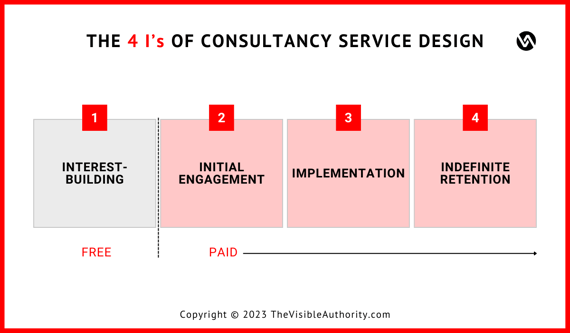
The 4 I’s of Service Design for Boutique Consultancies

It amazes me how many boutique consultancies overlook the importance of proper service design. They put together a list of services they offer, determine the fees and a general approach to working with clients within these service offerings, and call it a day.
But service design is so much more. It incorporates resource planning, marketing and client recruitment strategies, service offering implementation, client retention strategies, and more. How a consultancy maps out various interactions with prospects and clients and the methodologies it establishes can make or break a consulting business.
In this post, I will discuss an approach to service design that I have witnessed repeatedly delivering solid results.
The building blocks of service design: The 4 I’s
The approach I’m outlining today is a 4-step process that boutique consultancies can use to successfully recruit new clients and maintain long-term relationships with clients and, therefore, a more secure recurring revenue.
Based on this approach, consultancy leaders and their marketing teams can plan business development campaigns, nurture leads, and continuously provide value to clients.
The 4 I's of consultancy service design:
- Interest-building
- Initial engagement
- Implementation
- Indefinite retention
Ooh...and if you have multiple services, you can do two things:
- create the 4 I's approach for your most crucial flagship service
- create the 4 I's approach for every service of the consultancy (my favourite, but much work BUT also a motivation to keep the number of services as lean as possible)

I’ll explain each step in more detail.
Tier 1: Interest–building (self-assessment)
Goal: Inspire prospects to shift their thinking and build trust.
I recommend that consultancies think of a free, low-entry service/tool they can offer their prospects as the first tier in their consultancy service design.
A self-assessment service is an excellent example of that. A consultancy can design an online questions-based assessment tool that will serve as a way for prospects to better categorize their pain points, uncover potential roadblocks and mechanisms, and benchmark against other companies of similar size in the industry.
The self-assessment tool and the results it presents to prospects facilitate a shift in their thinking: “Am I really so far behind competitors on Process XYZ?”, “I didn’t realize this pain point is an operational challenge that can be permanently eliminated”, “Do I really want to wait till Problem X has such an exponentially large negative impact on Departments 1, 2, and 3?”
A free service like this should be enhanced by a library of educational content produced by the consultancy – blog articles, bite-sized advice on LinkedIn, podcast episodes, a newsletter, or a mix of these. This is how the consultancy builds trust with the audience whose interest in a particular area has successfully peaked.
A low-entry free offering like a self-assessment tool should be designed to be 100% systematized – it’s something the consultancy puts a lot of thought and effort into setting up and then lets it run.
Marketing teams then think of ways to maximize the visibility of the offering (e.g., inserting a CTA in blog articles, promoting a dedicated landing page through social media channels, etc.).
Tier 2: Initial engagement (discovery service)
The next tier in the service design is a paid, upfront discovery service.
An upfront discovery process in consulting is a systematized method of gathering pertinent information on the client’s pressing business problem and analyzing gaps and roadblocks to develop an improvement roadmap that will guide the client to achieve the desired business outcomes.
I’ve seen consultancy firms offering this service for free too often. They spend hours and dedicate various resources to diagnosing the state of their prospect. They create custom proposals based on the outcomes of the discovery. Then, way too often, one of two things happens:
- These consultancies engage in endless follow-ups, trying to close this prospect for a paid service.
- After spending valuable resources to conduct the free discovery, it turns out it’s either not the correct type of client, or the consultancies still have no definitive idea of whether the client is the right fit.
Tiers 1 and 2 help consultancies avoid the qualification trap. They enable a boutique consultancy to disqualify the prospect early in case of a non-fit.
I strongly encourage boutique consultancies to never start a critical client engagement without a paid, upfront discovery step.
This step is an opportunity for consultancies to get a solid understanding of what the implementation will entail and set clear expectations for the client. For clients, it’s also an opportunity to engage consultancies in a low-stake manner – gauge their expertise before committing further financial resources.
The end product is an improvement roadmap that outlines the symptoms of the problem, the problem itself, and the implementation process of a solution to the problem.
Everybody wins – the consultancy and its clients – when a discovery service is the first paid step in the engagement.
Recommended reading: Every Consulting Firm Needs a Discovery Service
I urge consultancies to standardize (the process, the methodology, the data gathering, etc.) and productize (from a marketing point of view) this tier of service offering.
There should be a systemic approach to the discovery service: how long it takes, what it entails, what resources get allocated, how the improvement roadmap is created and shared with the client, etc. The consultancy should know precisely what it takes to conduct the discovery and price it as a package accordingly.
Tier 3: Implementation
The discovery service is a fantastic way to set up both the consultancy and the client for success in the implementation stage. It enables consultancies to determine the scope of the implementation project and to set proper expectations with the client.
The 3rd service tier is the implementation based on the improvement roadmap produced in the 2nd discovery tier.
Once again, I strongly recommend that consultancies standardize this service tier as much as possible. Yes, each implementation project should be tailored to the context of each client. However, the methodology should have very little to no variation.
Recommended reading: Why A Boutique Consultancy Should Productize Its Expertise
This is the service tier where the consultancy delivers on all its promises and expectations set in the discovery stage. The transformational effect of this service tier should be substantial. The consultancy should be able to eliminate the pain point with laser-like precision, executing every step of the improvement roadmap within the targeted timelines utilizing resources that are perfectly trained and experienced to deliver successfully.
Implementation should be surgically precise, based on deep expertise, and offer massive value to the client.
Tier 4: Indefinite retention
Upon completing the implementation of the 3rd tier of the services, consultancies can transition their clients into a long-term type of partnership. The goal is to design a service that continuously adds value to the client.
Here, the services themselves depend on the expertise and core competencies of the consultancy. These are just a few examples:
- Continuous monitoring of the client’s processes and a monthly/quarterly report with recommendations
- Health checks
- Training the broader organization of the client to improve adoption
- Mentoring the CEO/CxOs of the company, thus providing the client with peace of mind
- Tech updates/upgrades consulting
- Subscription-based access to benchmarking and other proprietary datasets
Vertical service integration is another way to retain clients past the original implementation service tier.
Vertical service integration in consulting refers to the strategic expansion of services within a specific domain of expertise. It's about progressively deepening the consultancy's service offering, providing a spectrum of solutions ranging from broad strategic advice to highly specialized, granular interventions.
This approach cultivates richer expertise, enables a more comprehensive service to clients, and fosters a deeper understanding of the patterns, intricacies and nuances within a particular field.
Recommended reading: Why Vertical Service Integration Is the Future of Growth for Boutique Consultancies
Ensuring a balance between client acquisition and retention using the 4 I’s service design framework
I am a big proponent of consultancies striving to derive 70% of their revenue from existing clients through long-term collaboration and 30% through new client acquisition.
As I explain in my dedicated article on this topic, 70/30 is the split that firms should aspire to and that high-performance consultancies come close to. Most consultancies do not achieve and maintain such a ratio.
Why is 70/30 between farming and hunting the optimal ratio? Because it puts revenue stability first while leaving a significant portion for growth and expertise development. In my experience working with consultancy firms, this ratio allows firms to grow sustainably.
When the bulk of the revenue comes from long-term client engagements, consultancy owners and leaders can project and manage the pipeline of work with a high degree of precision. They can forecast revenue, efficiently plan out and allocate resources, and have enough financial stability to work on the consultancy instead of working in the day-to-day execution of projects.
Recommended reading: How to Balance Hunting and Farming for Sustainable Consulting Growth
The 4 I’s framework I propose facilitates precisely that – creating a 70/30 balance between client retention and client acquisition.
- Tier 1 – Interest-building – provides a mechanism for consistently generating interest in the consultancy’s services and acquiring new clients.
- Tiers 2 and 3 – Initial engagement (discovery) and Implementation – allow the consultancy to establish strong relationships with the client by expertly delivering a service.
- Tier 4 – Indefinite retention – enables consultancies to set up recurring revenue channels by maintaining long-term client relationships.
Based on this 4-tier service design strategy, consultancies can set up processes, resources, and marketing campaigns. Over time, they can collect data on how well these systems work and optimize them for maximum efficiency and ROI.
In conclusion
The 4 I's of service design for boutique consultancies offer a framework that boutique consultancy owners and leaders can use to set up their services in a way that enables long-term success.
Considering we live in an era of hiring challenges, growing a consulting business by increasing the number of services and consultants is not a sustainable strategy.
The four-tiered approach, from Interest-building to Indefinite retention, provides a structured path for consultancies. It encourages consultancies to provide initial value through free or low-entry services, followed by a paid discovery service that sets clear expectations, defines the scope of intervention and strengthens trust in the expertise.
The Implementation phase allows consultancies to deliver on their promises with precision, while the Indefinite retention phase offers opportunities for ongoing value delivery and continuous collaboration.
This framework supports client acquisition and provides consultancy owners with peace of mind in the form of recurring revenue, ultimately leading to a more stable and prosperous consultancy.
Interested in receiving all my learnings to build a better consultancy?
Subscribe to my newsletter.

Luk’s extensive career in the consulting business, which spans more than 20 years, has seen him undertake a variety of influential positions. He served as the European CHRO for Nielsen Consulting (5,000 consultants in the EU), founded iNostix in 2008—a mid-sized analytics consultancy—and led the charge in tripling revenue post-acquisition of iNostix by Deloitte (in 2016) as a leader within the Deloitte analytics practice. His expertise in consultancy performance improvement is underlined by his former role on Nielsen's acquisition evaluation committee. After fulfilling a three-year earn-out period at Deloitte, Luk harnessed his vast experience in consultancy performance improvement and founded TVA in 2019. His advisory firm is dedicated to guiding consulting firms on their path to becoming high-performing firms, drawing from his deep well of consulting industry expertise and financial acumen.

